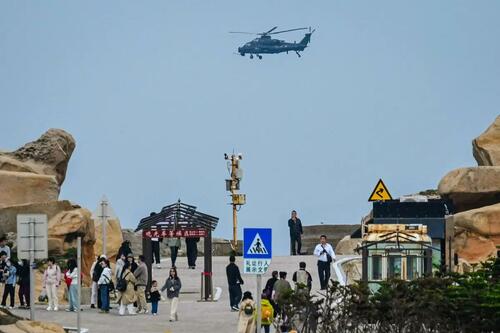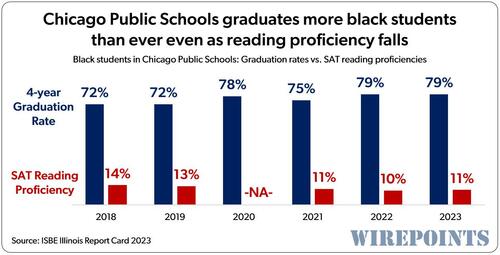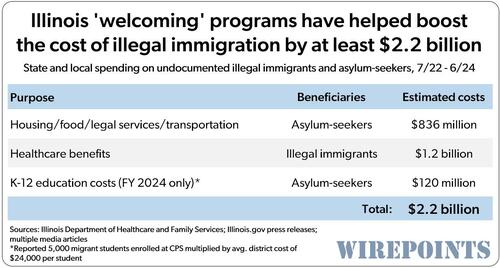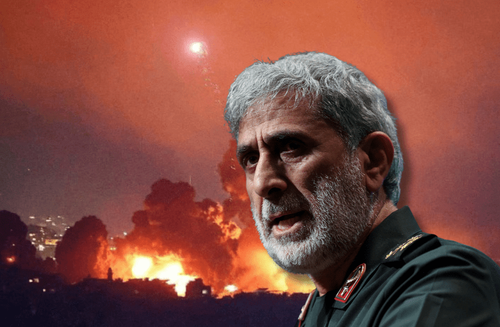Authored by Clayton Baker via The Brownstone Institute,
This article was co-authored by Brian Hooker, PhD and Heather Ray.
“Pandemic Preparedness,” and the gain-of-function research that underlies it, operates under a grand deception, a big lie.
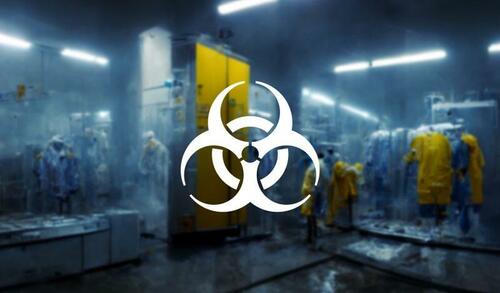
The Biological Weapons Convention, which every major nation has signed, “prohibits the development, production, acquisition, transfer, stockpiling and use of biological and toxin weapons.” As a result, gain-of-function research – the process of taking viruses and other pathogens found in nature and making them more transmissible and dangerous in humans – must be justified by defining it as something other than what it really is – namely, the creation of biological weapons and countermeasures for those weapons.
The grand deception – the big lie – used to justify gain-of-function research goes something like this: “We need to alter pathogens in the lab to anticipate the mutations that just might occur in nature, and to promote the production of vaccines to protect humanity from these theoretical superbugs.”
In truth, there is no legitimate reason to create superbugs in the laboratory. One does not save Tokyo by creating Godzilla. Unfortunately, science can be both complicated and confusing, especially when the “experts” are intentionally untruthful. This grand deception has therefore worked for decades, and a gigantic, profitable, and frankly terrifying pandemic preparedness industry involving governments, non-governmental organizations, Big Pharma, and universities has grown as a result.
In order to expose and discredit a big lie that has persisted for such a long time, sometimes a “smoking gun” is needed – that is, a piece of clear and obvious evidence that the long-held premise is false. In the case of the big lie surrounding gain-of-function research and the pandemic preparedness industry, monkeypox serves the role of smoking gun.
Monkeypox virus is back in the news in 2024, as one of the pandemic industrial complex’s leading candidates for the so-called “Disease X” about which the World Health Organization has been sounding its relentless alarm. (Of course, this is the second time monkeypox has been trotted out in recent years, after the 2022 monkeypox fear porn campaign in the United States that ultimately fizzled out.)
Once one gains a thorough understanding of both the monkeypox virus’s peculiar history in the US, as well as the natural characteristics of the virus, one can easily see through the grand deception – the big lie – that is used to justify gain-of-function research and the entire “pandemic preparedness” industry.
Monkeypox Comes to America
In 2003, through exotic pet importation, 35 people in six US states were confirmed to have been infected with the clade II type of the monkeypox virus. The humans contracted the disease from infected prairie dogs, kept as pets, that had themselves been exposed to either contaminated imported animals or other individuals infected with the virus. All human cases made a full recovery without lasting effects.
This outbreak was an odd, self-limited, and entirely incidental occurrence of a rare and essentially non-lethal virus finding its way to the US by specific and preventable circumstances. In a world of sensible and ethical public health practices, this event should have prompted a reasonable, proportionate response, such as increased precautions regarding the exotic animal trade.
Instead, this incident opened the floodgates to dangerous research by scientists who sought to identify a strain of monkeypox that could easily be passed to humans by way of aerosol transmission.
In 2009, Christina Hutson and her team at the CDC collaborated with Jorge Osorio at the University of Wisconsin to investigate the transmissibility of monkeypox. Again, in 2012, Hutson teamed with other universities to test and compare the transmissibility of the monkeypox virus in rodents, ultimately determining in those experiments that “transmission of viruses from each of the MPXV clade was minimal via respiratory transmission.”
Again, in a sensible and ethical world, these findings might have shut the door on ill-advised research on monkeypox. As we shall see, that was not the case.
Monkeypox: A Lumbering Giant of a Virus
The monkeypox virus itself is a strange candidate indeed to try to manipulate in the manner Hutson and Osorio sought. Unlike small, simple, rapidly mutating RNA respiratory viruses like Influenza viruses or coronaviruses, monkeypox is, in the virus world, a slow-moving, lumbering giant.
The most ‘successful’ bioweapon in human history is the SARS CoV-2 coronavirus that causes Covid. It encodes only 29 proteins in its single-stranded, RNA genome, which is correspondingly small – slightly less than 30,000 bases in length. With its genetic simplicity and its single-stranded RNA genome, it mutates very rapidly. The virus itself is small as well – it is only about 100 nanometers in diameter and weighs about 1 femtogram (or 0.000000000000001 gram).
As one might expect, this virus is readily transmitted through the airborne route.
Monkeypox virus, by contrast, is one of the largest and most complex viruses in existence. It can be up to 450 nm long and 260 nm wide, and its double-stranded DNA genome has nearly 200,000 base pairs. With this lengthy, complex genome, encoded in more stable, double-stranded DNA, it mutates slowly. This large virus – a giant, by viral standards – does not transmit by the aerosol route. Rather, it is transmitted by close contact, including sexual intercourse (as became well known during the 2022 monkeypox scare), as well as the hunting, slaughtering, and eating of bushmeat.
Consider also that naturally occurring monkeypox is much less deadly to humans than the pandemic planners and fear pornographers typically advertise. The WHO has since reported on the international monkeypox outbreak that occurred in 2022. As of January 2023, the total number of confirmed cases was 84,716, with 80 total deaths. Thus, the case fatality rate during that outbreak was less than one death in every thousand cases, 100 times less than the frequently-cited case-fatality rate of 10%.
Strictly speaking, the frequently cited 10% case-fatality rate refers only to the more virulent clade I of monkeypox. However, many authorities have picked up the bad habit of bandying about the 10% figure indiscriminately of clade. Furthermore, even with clade I, this rate appears to be a significant exaggeration.
For example, in its webpage on endemic clade I Monkeypox in the Democratic Republic of the Congo, the CDC states that “Since January 1, 2024, the Democratic Republic of the Congo (DRC) has reported more than 31,000 suspect mpox cases and nearly 1,000 deaths.” These numbers result in a case fatality rate of around 3%.
There are numerous other threats to human health that are more worthy of time, funding, and effort. For example, in the Democratic Republic of the Congo, where monkeypox is endemic, about eighty times more people die of malaria than of monkeypox. Malaria is both preventable and curable with proper diagnosis and access to inexpensive medications. This tragic death toll from malaria illustrates how common, deadly, but relatively unprofitable diseases are neglected by supposedly philanthropic entities such as the WHO.
Instead, they heavily promote the grand deception of pandemic preparedness and gain-of-function research.
Given the monkeypox virus’s sheer size, complexity, low rate of mutation, relatively stable DNA genome, and instability when exposed to oxygen, the likelihood of it ever naturally mutating into an airborne pathogen is remote. There is simply no legitimate reason to monkey with its genome in the lab (pun intended).
Add to the mix its limited transmissibility and low mortality (especially for clade II), and any honest and competent scientist truly seeking to serve humanity would recognize that naturally occurring monkeypox is a relatively low public health priority and a marginal-at-best vaccine candidate – especially for the world population at large.
But Anthony Fauci and his cronies at NIAID saw things differently.
Fauci and Friends, at It Again
In 2015, AnthonFauci’s National Institute of Allergy and Infectious Disease (NIAID) covertly approved a dangerous gain-of-function experiment that would genetically manipulate the monkeypox virus to create a more virulent and transmissible pathogen that would potentially pose a grave threat to humans.
Instead of raising the alarm about this proposal to create a deadly hybrid monkeypox virus, the Department of Health and Human Services (HHS), the National Institutes of Health (NIH), and NIAID itself deceptively hid the project’s approval from the oversight of the House Committee on Energy and Commerce, by burying funding for the experiment in an alternate grant.
The project was proposed by Dr. Bernard Moss, a long-time friend and colleague of Fauci at NIAID. Moss, who has accumulated multiple US patents related to monkeypox, intended to insert virulence genes from the more severe form of monkeypox, clade I (Congo Basin clade), in the “backbone” of the more transmissible monkeypox virus, clade II (West Africa clade). This project would create a much more dangerous version of monkeypox with the virulence of clade I and the transmissibility of clade II. This chimeric form of monkeypox would not originate in nature, as different clades of DNA viruses do not naturally transpose genes.
It is unknown whether this ill-advised, highly dangerous, and deceitfully approved project was completed. Fauci and Moss’s sleight-of-hand was discovered in 2022, prompting a seven-month Congressional investigation. The House Committee Report (page 6) states that “HHS, the NIH, and NIAID continue to insist the GOFROC (gain-of-function research of concern) experiment transferring material from clade I to clade II was never conducted, despite being approved for a period of over 8 years. However, HHS has repeatedly refused to produce any documents that corroborate this claim.”
Is a weaponized form of monkeypox in existence? If so, Fauci, Moss, and friends aren’t telling.
What is known is that there was no legitimate reason to conduct such experiments, and that those involved knew this, as they hid the project from their overseers. The only logical assumption about the intent of the research is that it was to create a weaponized version of monkeypox.
The House Committee’s conclusions on Fauci’s NIAID as a whole are damning:
The primary conclusion drawn at this point in the investigation is that NIAID cannot be trusted to oversee its own research of pathogens responsibly. It cannot be trusted to determine whether an experiment on a potential pandemic pathogen or enhanced potential pandemic pathogen poses unacceptable biosafety risk or a serious public health threat. Lastly, NIAID cannot be trusted to honestly communicate with Congress and the public about controversial GOFROC experiments. (page 8)
NIAID couldn’t be trusted about Covid.
They cannot be trusted about monkeypox, either.
According to the House Committee on Energy and Commerce, they cannot be trusted, period.
To summarize: in nature, monkeypox disease is a relatively rare, usually mild viral illness transmitted through behaviorally modifiable forms of close contact such as sexual intercourse and the hunting and eating of bushmeat. The infectious agent is a very large, complex DNA virus that transmits poorly from person to person and is much less prone to mutation than numerous other viruses.
Once one realizes all this, it becomes frankly preposterous to attempt to justify gain-of-function research on such a pathogen for any legitimate purpose. The only plausible reason to do such research on monkeypox is to create a bioweapon – a weaponized virus – and to also create and profit from its countermeasure – a proprietary vaccine.
Pandemic preparedness is a grand deception, a big lie. The monkeypox madness demonstrates this, as compellingly as a smoking gun at a murder scene. We must put an end to all gain-of-function research and to the bogus pandemic preparedness excuse for illegal bioweapons research.





